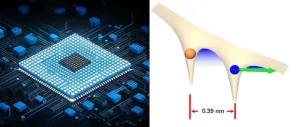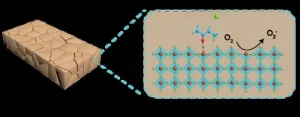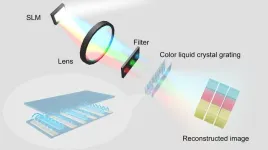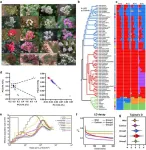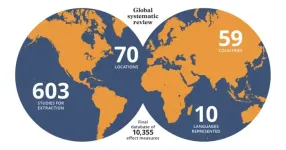(Press-News.org) Bottom Line: Imaging the tumors of patients with advanced melanoma receiving pembrolizumab (Keytruda) after only one week—rather than the standard of around three months—identified metabolic changes that corresponded with treatment response and progression-free survival (PFS).
Journal in Which the Study was Published: Clinical Cancer Research, a journal of the American Association for Cancer Research (AACR)
Author: Michael D. Farwell, MD, an associate professor of radiology at the Hospital of the University of Pennsylvania
Background: Cancer immunotherapy has helped transform the standard of care for many malignancies, but not all patients respond to therapy, and the treatment can cause severe adverse events. Typically, immunotherapy patients are imaged around three months after starting treatment to monitor their progress, with some more recent trials exploring the value of performing scans after three to six weeks, and in some cases closer to two weeks. But Farwell designed a study to explore if results could be observed even sooner. The goal was to identify a noninvasive imaging biomarker that could guide the management of patients on these therapies and avoid toxicity in patients not likely to benefit.
Farwell and his colleagues hypothesized that by using 18F-fluorodeoxyglucose (FDG) PET/CT, which is one of the most common and readily available ways to test for cancer, they could see if patients experienced metabolic changes in tumors after a week on therapy. When a patient responds to immunotherapy, activated immune cells infiltrate into the tumor, so the scans are expected to first show an increase in FDG activity, which Farwell calls a metabolic flare (MF). Then, as the tumor responds to therapy, the tumor cells die and pass back through a stable metabolism phase and ultimately end at a metabolic response (MR), indicated by a decrease in FDG activity. In contrast, the tumors of nonresponding patients are expected to maintain stable metabolism.
“If you’re imaging after three weeks, you’re unlikely to catch this flare, because response to immunotherapy happens so quickly and, in some cases, it’s already done—there’s no tumor left,” Farwell explained. “The other nice thing about imaging at a week is we are looking at this response curve over a pretty short interval. If you wait to monitor progress over longer intervals, it means the tumor has more time to grow in nonresponders, which can complicate the analysis.”
How the Study was Conducted: To test their hypothesis, the researchers recruited 21 patients with advanced melanoma scheduled to initiate pembrolizumab. As part of the trial, patients were required to have at least one measurable lesion and could not have received previous anti-PD-1 or anti-PD-L1 therapies. FDG PET/CT imaging was performed on each patient within four weeks prior to their start of therapy and then at about one week after the first dose of pembrolizumab. Two patients did not complete both scans, so their results were excluded.
Results: FDG activity for each lesion was measured using the maximum standardized uptake value (SUVMAX). For the purposes of this study, an MF was defined as a greater than 70% increase in tumor SUVMAX and an MR as a greater than 30% decrease in tumor SUVMAX. An MF or MR was identified in 55% of the patients who responded to treatment (6 out of 11) and 0% of patients who did not respond (0 out of 8). An MF or MR also correlated with longer survival, with 83% of the MF-MR group seeing an overall survival of three years compared to 62% in the group with stable metabolism. Additionally, median PFS was greater than 38 months in the MF-MR group and 2.8 months in the group with stable metabolism.
Author’s Comments: Farwell said they not only observed heterogeneity in the kinetics of response between patients, they also observed heterogeneity among lesions in the same patient. That is a challenge Farwell hopes to address in future studies. Further, because tumors pass through a stable metabolism phase between MF and MR responses, it will be key to identify if a tumor with stable metabolism is in fact responding but is in between reaction phases. Farwell says some potential solutions for that include layering on companion studies such as blood tests, a CD8 PET scan, or serial FDG PET/CT imaging to better plot out the change over time.
“While the results need to be validated, this has the potential to be broadly applicable and offer physicians the ability to deescalate therapy or avoid surgery in patients who are responding, identify nonresponders who may need an escalation of therapy, and to be used in phase I clinical trials to test if a therapy is working,” Farwell explained.
Study Limitations: Limitations of the study include a relatively small sample size from a single institution, which did not include patients with stable disease. Also, there were variable intervals between a patient’s first scan prior to therapy initiation and their scan after therapy initiation. Additionally, four different PET/CT scanners were used, which could have caused variability in SUV measurements.
Funding & Disclosures: The study was supported by research grants from the Investigator Studies Program of Merck Sharp & Dohme LLC, ImaginAb, the National Cancer Institute of the National Institutes of Health (including the Specialized Program of Research Excellence (SPORE) in Skin Cancer), the RSNA Resident/Fellow Research Grant, the Tara Miller Melanoma Foundation, the Melanoma Research Alliance, the David and Hallee Adelman Immunotherapy Research Fund, and the Parker Institute for Cancer Immunotherapy Bridge Scholar Award. Farwell also reports grants from Bristol Myers Squibb and Carisma Therapeutics as well as personal fees from Abcuro, Inc. outside the submitted work.
END
FDG PET/CT imaging after just one week may predict treatment response in patients with advanced melanoma
2024-01-24
ELSE PRESS RELEASES FROM THIS DATE:
Centralized social networks potentially hinder innovation by making decision-making too similar
2024-01-24
Social systems where influence is focused around one or a few individuals may create environments where new ideas are ignored, and innovation is hindered.
This is according to a study published today in People and Nature by researchers at the University of Sydney and Stockholm University. It looked at the social networks and fertiliser use of 30 rural, cocoa-producing villages in Sulawesi, to examine how innovative and sustainable farming practices are adopted among communities.
It found that when one or two farmers hold a disproportionate level of influence (often due to their roles as "model farmers" in official sustainability programs) ...
Tunnelling of electrons via the neighboring atom
2024-01-24
Tunnelling is one of most fundamental processes in quantum mechanics, where the wave packet could traverse a classically insurmountable energy barrier with a certain probability. Within the atomic scale, tunnelling effects play an important role in molecular biology, such as accelerating enzyme catalysis, prompting spontaneous mutations in DNA and triggering olfactory signaling cascades. Photoelectron tunnelling is a key process in light-induced chemical reactions, charge and energy transfer and radiation emission. The size of optoelectronic chips ...
Space-based landscape site perception: Teaching principles and methods for the basic course of landscape architecture
2024-01-24
Replacing abstract form-making training with the perception of landscape site has been an important trend in the basic course of landscape architecture. Based on theoretical research and the authors’ teaching practice, this article aims to explore the significance, objects, and methods of site perception training. The authors argue that because landscape design is stemmed from the perception and interpretation of site characteristics, experiencing landscape sites must precede form-making training to become the foundation of design learning. Human-scale spaces that concern elements, structure, processes, and feelings for perception, representation, ...
Suppression of deep-level traps for lead-free perovskite solar cells
2024-01-24
Tin perovskites have gained tremendous attention in lead-free perovskite solar cells. However, Sn vacancies and undercoordinated Sn ions on the tin perovskite surfaces can create deep-level traps, leading to non-radiative recombination and absorption nucleophilic O2 molecules, impeding further device efficiency and stability.
Researchers led by Prof. Ligang Xu at Nanjing University of Posts & Telecommunications, China, are interested in lead-free perovskite solar cells, where the deep-level traps lead to inferior efficiency and stability. The work first introduced semicarbazide hydrochloride (SEM-HCl) into ...
Color liquid crystal grating based color holographic 3D display system with large viewing angle
2024-01-24
Holographic display technology provides an ultimate solution for real 3D display and has great potential in augmented reality and virtual reality. However, the color and viewing angle of holographic 3D display mainly depend on the wavelength of the laser and the pixel size of the current spatial light modulator. Inevitable color differences and narrow viewing angle in conventional systems seriously affect the holographic display effect and hinder the application of holographic 3D display in many fields.
In a new paper published in Light: Science & Application, a team of scientists, led by Professor Qiong-Hua Wang from Beihang ...
Walking fitness can predict fracture risk in older adults
2024-01-24
The ability to walk one kilometre comfortably can help predict fracture risk, according to researchers at the Garvan Institute of Medical Research. The findings, published today in JAMA Network Open, suggest that simply asking a patient about walking limitation could allow clinicians to identify those in need of further bone health screening and prescribe interventions that could prevent fractures from occurring.
“We’ve discovered that trouble walking even short distances appears closely tied to higher fracture risk over the following five years,” says lead author of the study, Professor ...
Genome assembly and resequencing analyses provide new insights into the evolution, domestication and ornamental traits of crape myrtle
2024-01-24
Crape myrtle (Lagerstroemia indica), a widely cherished ornamental plant, boasts a rich history, originating in Southeast Asia to Oceania and flourishing in cultivation centers like China for over 1600 years. Renowned for its unique blooming during the summer peak, it has evolved through extensive hybridization, and now includes more than 200 species. Current research has made strides in understanding the determinants of plant architecture, flower, leaf color, and dwarfism traits through transcriptomics and QTL mapping. However, the absence of a reference genome for L. indica severely limits comprehensive ...
Learning for life: The higher the level of education, the lower the risk of dying
2024-01-24
Education saves lives regardless of age, sex, location, and social and demographic backgrounds. That’s according to the latest and largest study of its kind published today in The Lancet Public Health.
Researchers have known that those who reach higher levels of schooling live longer than others, but they didn’t know to what extent until now. What they found was that the risk of death drops by two per cent with every additional year of education. That means those who completed six years of primary school had a lower risk of death by an average of 13 per cent. After graduating from secondary school, the risk ...
Community perinatal mental health teams reduce risk of mental health relapse after childbirth
2024-01-24
New research from the Institute of Psychiatry, Psychology & Neuroscience (IoPPN) at King’s College London, and in partnership with the University of Exeter and the London School of Hygiene & Tropical Medicine, has found that women with a history of severe mental illness face a lower risk of relapse after giving birth in regions where they have access to a community perinatal mental health team (CPMHT).
The research, published in Lancet Psychiatry, is the first of its kind to evaluate the effectiveness of CPMHTs, and suggests that women with access to specialist support have a reduced risk of acute relapse after birth, but also highlights the importance of the need for ...
Non-COVID-19 deaths among people with diabetes jumped during pandemic
2024-01-24
Non-COVID-19-related deaths among people with diabetes increased during the pandemic, as did the diabetes complication of sight loss, according to a global study review led by a University of Massachusetts Amherst public health researcher that examined the impacts of pandemic-related disruptions on this vulnerable population.
The review, commissioned by the World Health Organization (WHO) and published Jan. 23 in The Lancet Diabetes and Endocrinology, looked at 138 studies comparing pre-pandemic to during pandemic periods in North America (39), Western Europe (39), Asia (17), Eastern Europe (14), South America (four), Egypt (one), Australia ...
